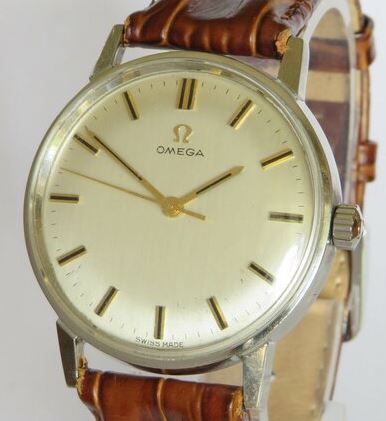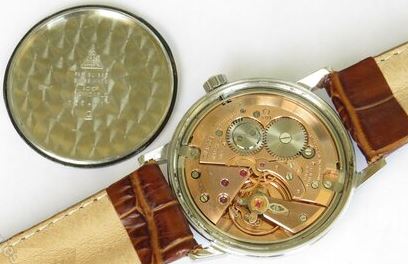Last Updated on September 27, 2025 by Jason
Omega Seamasters feature prominently at Set Back In Time. It’s hard not to like a Seamaster. The Omega brand has history, and the Seamaster range has proven itself to be a reliable, rugged timepiece for over 70 years. As collectors, we value originality and authenticity. We aren’t investors. We just appreciate vintage watches. That said, none of us wants to purchase a vintage watch that won’t hold its value for resale. And this is why originality matters. In today’s post, we are going to take a look at a perfectly functional timepiece that is no longer “original”, a 1965 Omega Seamaster with a replacement service dial from Omega.
A brief history of Omega and the Seamaster
Omega’s history began in 1848 with Louis Brandt’s watchmaking business. Over the decades, the company evolved. In 1894, the company developed an in-house movement known as the 19 ligne calibre, which was manufactured using revolutionary new methods and set new standards for watchmaking. The new movement was named ‘Omega’, which means the extreme or final part. The movement became very popular with the public, resulting in the official adoption of the brand name Omega in 1903 (Omega at Watch Wiki).

Seamaster
The Omega Seamaster line was introduced in 1948. It was a significant launch celebrating the brand’s 100th anniversary. Its initial inspiration was drawn from the robust and reliable watches designed for military use during World War II. Early Seamaster models featured innovations, such as the innovative O-ring gasket, specifically designed for enhanced water resistance, setting a new standard for civilian watches (Omega Seamaster history at the Gentlemen’s Journal).
Throughout the 1950s and 1960s, the Seamaster underwent dynamic development, gracefully transitioning from refined, elegant dress watches to more rugged and purpose-built designs. This period saw the introduction of key milestones, including the iconic Seamaster 300, launched in 1957 for professional divers. The distinctive Hippocampus (seahorse) logo was introduced to the case backs in 1958. The Seamasters had evolved from a refined water-resistant timepiece to a rugged “tool watch“.
Originality, a case study
Several components of this watch are known to be original. These are positives that form a foundation for overall authenticity and desirability. The original movement is particularly crucial, as it typically bears Omega serial number and calibre markings. These can be cross-referenced with Omega’s production records for authentication and precise dating. The presence of the original case and a correctly signed Omega winding crown further contributes to the watch’s integrity. Additionally, the crystal is original. A tiny etched Omega logo is visible on the lens. It is worth noting that crystal replacement is a common occurrence in vintage watches due to breakage. However, this is one component that generally has minimal impact on value when replaced. The big issue on this particular Seamaster is the replacement dial.
Replacement dial
The key issue with this 1965 Seamaster lies in the use of an official Omega service replacement dial. While this dial is signed “Omega” and “Swiss Made”, a crucial detail is its conspicuous lack of the “Seamaster” signature. Obviously, at some point, the watch was presented to Omega for a service, and the dial was in a damaged state. As is usual, for most high-end watchmakers, the damaged dial was replaced with a service dial (Service dials at Hodinkee). We would think that the logical choice would be to replace like for like, but clearly this isn’t the case. The absence of the “Seamaster” signature means it deviates significantly from the watch’s factory configuration, even if manufactured by Omega. This distinction is important for collectors who value historical accuracy and originality, and it directly impacts market value.
The dial is, without exaggeration, the “heart and soul” of a vintage watch’s market value and collectibility. As the most visible component, it instantly conveys the watch’s identity, brand, model designation, and overall character. Its condition and originality are key for several reasons. Firstly, as the primary interface, the dial is the first element a potential buyer or admirer observes. Secondly, the dial typically bears the brand name, model name (e.g., “Seamaster”), and other crucial markings, which are fundamental to identifying and valuing the specific watch. Thirdly, the natural ageing process, often referred to as “patina,” on an original dial has an appeal to collectors. The discolouration through patina, particularly “tropical dials“, is highly sought after by collectors.
Omega calibre 601
The watch has a calibre 601 hand-winding movement, which is working and keeping good time. The movement is signed Omega, and it has a serial number which dates it back to 1965. According to EmmyWatch, the Omega 601 has sweep seconds and Incabloc Shock Protection. It was in production between 1962 and 1970. It had 17 jewels, a power reserve of 48 hours and a frequency of 19,800 vph. The Omega calibre 601 is a highly regarded, manual-wind movement found in various vintage Omega watches, particularly the Seamaster and Genève lines. The calibre 601 is known for its reliability, accuracy, and simple yet elegant design, making it a popular choice for vintage watch collectors.

Case
The watch measures 34mm in diameter, excluding the winding crown and the lugs. The case is stainless steel, and it is in good condition, with just a couple of minor surface marks to the back. The screw-on case back has a faded Seamaster logo on the outside, and the Omega logo on the inside, along with the case reference 135.011, which is correct for the calibre 601 movement. The first digit, 1, represents a “Gent’s Watch”, which, in terms of size, is suitable for a man’s wrist. The 3 signifies a “Manual winding centre second” movement. And the 5 indicates a “Water-resistant” case. The final three digits, .011, represent the specific combination of case shape, dial configuration, and bracelet or strap style. In this instance, it belongs to the 1960s Omega Seamaster 600 range (The Omega model decoder).
The signed Omega winding crown is original. The crystal lens is in good condition, and it has the tiny, clear Omega logo at its centre. As a group of collectors, we generally look for original crowns, which are often hard to find on manual-wind watches. The original crystal is a particularly nice find, as the crystal is generally the most likely component, apart from a leather strap, to break.

Summary
This article wasn’t meant to be a criticism of the watch. As a vintage timepiece, it is a reliable and practical tool. However, if you were a collector who likes “flipping” their watches (selling one to buy another), you would be unlikely to recoup your costs when reselling this watch. An Omega Seamaster with a replacement dial, just simply won’t retain its value. This all comes down to the premium that vintage watch collectors place on originality.
It is very rare to find a vintage timepiece in mint condition, but if you can be sure that most of the components are original, you might just make your money back on resale. That said, ultimately, buy the vintage watch that you want to wear. That’s the best advice we could give. And despite all of the comments above, someone followed that advice and purchased this watch before we even came across it. What do we know?
Related content
Creation of the Seamaster at Omega.
Leave a Reply